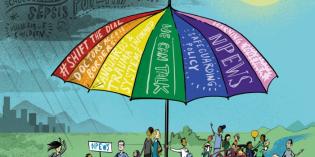Embed and spread
As you begin, you can start in one clinical area with one huddle a day. Make sure you have a reliable process with a set script that meets the purpose of the clinical area.
Use multiple plan, do, study, act cycles (PDSAs) (described in module 1) to perfect the process. You can then do two huddles a day, and then huddles on nights and weekends.
Once the process is credible, easy to do and has both intrinsic and extrinsic benefits, you can spread to a new clinical area.
This 'embed and spread cycle' can be done rapidly over one week with a motivated, activated team that owns the problem and solution. There are a number of steps, detailed in the below diagram, but this will be easier as you become more adept.
Tools
Evaluating improvement is key to demonstrating success and this is a core component of spreading these improvements. These tools will help you select the right measures to demonstrate improvement and to develop your approach for spreading success.
One important point to factor in to your decisions on evaluation is to make sure that the measures you choose will truly help you demonstrate improvement. The SAFE programme learned that, while the core measures are useful at a national level, they have less meaning locally. We encouraged encouraged sites to identify more relevant local measures specific to their project.
We have introduced a number of tools in earlier sections, which you can revisit as part of your evaluation. These include the SAFE Measurement Plan in Section 1, where you should have already identified some of your process and outcome measures.
Evaluation: What to consider
This publication from The Health Foundation (PDF) covers 10 key questions that you should ask yourself when designing your evaluation. While the guide is not prescriptive or step-by-step, recognising the different needs of a wide variety of organisations will help get you thinking about what you need to get a robust and appropriate evaluation.
Communications in healthcare improvement toolkit
This toolkit from The Health Foundation takes you through practical actions to harness the power of communications. This should be a one-stop shop for communications across your project. More specifically, it will support you in any planned spread you have.
The Health Foundation describes it as follows:
No previous experience of communications is required. By working through this toolkit, you will: understand how to reach and win the support of the people who are key to your project’s success; assure yourself, and demonstrate to others, that you are following best practice in communications; see how communications can sustain interest in your project and encourage the spread of innovation and new ways of working; and, identify the materials and stories about your project that may help in re-commissioning or seeking further funding.
Evaluation
Following an extensive evaluation process, Anna Freud Centre has produced its findings in a report on the original S.A.F.E programme. You can download the evaluation below.
Dissemination and spread project
Having secured a grant from the Health Foundation, RCPCH has led on a regional spread and dissemination project for S.A.F.E which included five regional training events bringing together original S.A.F.E sites with new ‘buddy’ sites.
Following the training, the teams worked together to implement S.A.F.E methodology in their wards, with support from RCPCH and Dr Peter Lachman.
You can download training materials and presentations from events below.











